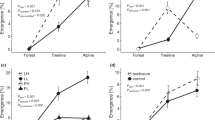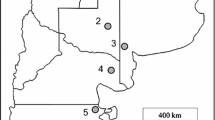Abstract
Seedling emergence and survival of 15 perennial species were studied for six years in a 557-m2 permanent plot at Tumamoc Hill, Arizona, USA, an ungrazed site in the northern Sonoran Desert. The minimum rain required for germination and emergence ranged from 17.5 to 35.6 mm. Few species emerged in every year of the study. First-year survival averaged across all 15 species was 3.7%; only 0.1% of seedlings lived as long as four years. The odds of survival in the first year improved with increased rain. About three times as many seedlings died from predation as desiccation. In 2-m2 subplots, mortality of three woody species in the first 30 days after emergence appeared to be independent of seedling density. Short-, moderate-, and long-lived species displayed distinct survival strategies. Long-lived species compensated for generally poor seedling survival by frequent germination and emergence. Moderate-lived species exhibited highly episodic germination and emergence, a potentially risky behavior that might have been offset to some extent by relatively good long-term survival. Short-lived species had the highest seedling survival. Because these species can bloom in their first year, good early survival meant that some individuals were able to reproduce before they died.
Similar content being viewed by others
References
Ackerman T.L. 1979. Germination and survival of perennial plant species in the Mojave Desert. Southwestern Naturalist 24: 399-408.
Augspurger C.K. and Kelly C.K. 1984. Pathogen mortality of tropical tree seedlings: experimental studies of the effects of dispersal distance, seedling density, and light conditions. Oecologia 61: 211-217.
Barbour M.G., Cunningham G., Oechel W.C. and Bamberg S.A. 1977. Growth and development, form and function. In: Mabry T.J., Hunziker J.H. and DiFeo D.R. (eds), Creosote Bush: Biology and Chemistry of Larrea in New World Deserts. Dowden, Hutchinson & Ross, Stroudsburg, Pennsylvania, USA, pp. 48-91.
Beatley J.C. 1974. Phenological events and their environmental triggers in Mojave Desert ecosystems. Ecology 55: 856-863.
Bowers J.E. 1994. Natural conditions for seedling emergence of three woody species in the northern Sonoran Desert. Madroño 41: 73-84.
Bowers J.E. and Pierson E.A. 2001. Implications of seed size for seedling survival in Carnegiea gigantea and Ferocactus wislizeni (Cactaceae). Southwestern Naturalist 46: 272-281.
Bowers J.E. and Turner R.M. 2002. The influence of climatic variability on local population dynamics of foothill paloverde (Cercidium microphyllum). Oecologia 130: 105-113.
Boyd R.S. and Brum G.D. 1983a. Postdispersal reproductive biology of a Mojave Desert population of Larrea tridentata (Zygophyllaceae). American Midland Naturalist 110: 25-36.
Boyd R.S. and Brum G.D. 1983b. Predispersal reproductive attrition in a Mojave Desert population of Larrea tridentata (Zygophyllaceae). American Midland Naturalist 110: 14-24.
Cayan D.R., Redmond K.T. and Riddle L.G. 1999. ENSO and hydrologic extremes in the western United States. Journal of Climate 12: 2881-2893.
Chambers J.C. and MacMahon J.A. 1994. A day in the life of a seed: Movements and fates of seeds and their implications for natural and managed systems. Annual Review of Ecology and Systematics 25: 263-292.
Ebert T.A. and McMaster G.S. 1981. Regular pattern of desert shrubs: a sampling artifact? Journal of Ecology 69: 559-564.
Goldberg D.E. and Turner R.M. 1986. Vegetation change and plant demography in permanent plots in the Sonoran Desert. Ecology 67: 695-712.
Howe H.F. and Smallwood J. 1982. The ecology of seed dispersal. Annual Review of Ecology and Systematics 13: 201-228.
Hunter R. 1989. Competition between adult and seedling shrubs of Ambrosia dumosa in the Mojave Desert, Nevada. Great Basin Naturalist 40: 79-84.
Jordan P.W. and Nobel P.S. 1979. Infrequent establishment of seedlings of Agave deserti (Agavaceae) in the northwestern Sonoran Desert. American Journal of Botany 66: 1079-1084.
Jordan P.W. and Nobel P.S. 1981. Seedling establishment of Ferocactus acanthodes in relation to drought. Ecology 62: 901-906.
Kahya E. and Dracup J.A. 1994. The influences of Type 1 El Niño and La Niña events on streamflows in the Pacific Southwest of the United States. Journal of Climate 7: 965-976.
Kartesz J.T. 1994. A Synonymized Checklist of the Vascular Flora of the United States, Canada, and Greenland. 2nd edn. Timber Press, Portland, Oregon, USA.
McAuliffe J.R. 1986. Herbivore-limited establishment of a Sonoran Desert tree, Cercidium microphyllum. Ecology 67: 276-280.
McAuliffe J.R. 1988. Markovian dynamics of simple and complex desert plant communities. American Naturalist 131: 459-490.
McAuliffe J.R. 1990. Paloverdes, pocket mice, and bruchid beetles: Interrelationships of seeds, dispersers, and seed predators. Southwestern Naturalist 35: 329-337.
McCabe G.J. and Dettinger M.D. 1999. Decadal variations in the strength of ENSO teleconnections with precipitation in the western United States. International Journal of Climatology 19: 1399-1410.
Miriti M.N., Howe H.F. and Wright S.J. 1998. Spatial patterns of mortality in a Colorado desert plant community. Plant Ecology 136: 41-51.
Morisita M. 1959. Measuring of the dispersion of individuals and analysis of the distributional patterns. Memoirs of the Faculty of Science of Kyushu University, Series E (Biology) 2: 215-235.
Owens M.K. and Norton B.E. 1989. The impact of' available area' on Artemisia tridentata seedling dynamics. Vegetatio 82: 155-162.
Owens M.K. and Norton B.E. 1992. Interactions of grazing and plant protection on basin big sagebrush (Artemisia tridentata ssp. tridentata) seedling survival. Journal of Range Management 45: 257-262.
Rivera R. and Freeman C.E. 1979. The effects of some alternating temperatures on germination of creosotebush (Larrea tridentata (DC.) Cov.: Zygophyllaceae). Southwestern Naturalist 24: 711-714.
Schupp E.W. 1995. Seed-seedling conflicts, habitat choice, and patterns of plant recruitment. American Journal of Botany 82: 399-409.
Schupp E.W. and Fuentes M. 1995. Spatial patterns of seed dispersal and the unification of plant population ecology. Ecoscience 2: 267-275.
Sheps L.O. 1973. Survival of Larrea tridentata S. & M. seedlings in Death Valley National Monument, California. Israel Journal of Botany 22: 8-17.
Sherbrooke W.C. 1977. First year seedling survival of jojoba (Simmondsia chinensis) in the Tucson Mountains, Arizona. Southwestern Naturalist 22: 225-234.
Sherbrooke W.C. 1989. Seedling survival and growth of a Sonoran Desert shrub, jojoba (Simmondsia chinensis), during the first 10 years. Southwestern Naturalist 34: 421-424.
Shreve F. 1911. Establishment behavior of the palo verde. Plant World 14: 289-299.
Shreve F. 1914. Rainfall as a determinant of soil moisture. Plant World 17: 9-26.
Shreve F. 1917. The establishment of desert perennials. Journal of Ecology 5: 210-216.
Shreve F. and Wiggins I.L. 1964. Vegetation and Flora of the Sonoran Desert. Stanford University Press, Palo Alto, California, USA, 1740 p.
Silvertown J.W. 1981. Seed size, life span, and germination date as coadapted features of plant life history. American Naturalist 118: 860-864.
Silvertown J., Franco M., Pisanty I. and Mendoza A. 1993. Comparative plant demography - relative importance of life-cycle components to the finite rate of increase in woody and herbaceous perennials. Journal of Ecology 81: 465-476.
Steenbergh W.F. and Lowe C.H. 1977. Ecology of the Saguaro: II. Reproduction, Germination, Establishment, Growth, and Survival of the Young Plant. National Park Service Scientific Monograph Series no. 8.
Swetnam T.W. and Betancourt J.L. 1998. Mesocale disturbance and ecological response to decadal climatic variability in the American Southwest. Journal of Climate 11: 3128-3147.
SYSTAT 1998. Statistics. SPSS Inc., Chicago, 1087 p.
Trexler J.C. and Travis J. 1993. Nontraditional regression analyses. Ecology 74: 1629-1637.
Turner R.M. 1990. Long-term vegetation change at a fully protected Sonoran Desert site. Ecology 71: 464-477.
Venable D.L. 1989. Modeling the evolutionary ecology of seed banks. In: Leck M.A., Parker V.T. and Simpson R.L. (eds), Ecology of Soil Seed Banks. Academic Press, New York, pp. 67-87.
Webb R.H. and Betancourt J.L. 1992. Climatic variability and flood frequency of the Santa Cruz River, Pima County, Arizona. Paper no. 2379. U.S.Geological Survey Water-Supply Paper no. 2319.
Went F.W. and Westergaard M. 1949. Ecology of desert plants III. Development of plants in the Death Valley National Monument, California. Ecology 30: 26-38.
Zedler P.H. 1980. Vegetation change in chaparral and desert communities in San Diego County, California. In: West D.C., Shugart H.H. and Botkin D.B. (eds), Forest Succession: Concepts and Application. Springer-Verlag, New York, pp. 406-430.
Author information
Authors and Affiliations
Rights and permissions
About this article
Cite this article
Bowers, J.E., Turner, R.M. & Burgess, T.L. Temporal and spatial patterns in emergence and early survival of perennial plants in the Sonoran Desert. Plant Ecology 172, 107–119 (2004). https://doi.org/10.1023/B:VEGE.0000026026.34760.1b
Issue Date:
DOI: https://doi.org/10.1023/B:VEGE.0000026026.34760.1b




